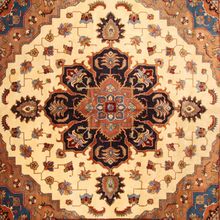Difference between revisions of "Medallion"
Jump to navigation
Jump to search
(Created page with "{{Infobox Design and Motif |above = |image = frameless|220px |caption = Medallion Design ([https://www.rugman....") |
|||
| Line 21: | Line 21: | ||
|Common designs = | |Common designs = | ||
|Common motifs & patterns = | |Common motifs & patterns = | ||
| − | |Weave Area = | + | |Weave Area = [[Isfahan Rug|Isfahan]], [[Kashan Rug|Kashan]], [[Nain Rug|Nain]], [[Tabriz Rug|Tabriz]], [[Heriz Rug|Heriz]], [[Kerman Rug|Kerman]], [[Yazd Rug|Yazd]] |
|additional info = | |additional info = | ||
Latest revision as of 11:23, 21 July 2020
| Medallion | |
|---|---|
 Medallion Design (Rugman) | |
| General information | |
| Name | Medallion |
| Original name | لچک و ترنج |
| Alternative name(s) | Lachak Toranj, Medallion, Shamsa (Arabic), Toranj |
| Origin | |
| Weave Area | Isfahan, Kashan, Nain, Tabriz, Heriz, Kerman, Yazd |
Medallion shamsa (Arabic), toranj (Persian). A large enclosed portion of a design usually located in the center of the field. Common shapes are diamonds, octagons, ovoids, hexagons, and stars. Medallions may be lobed or stepped. Where there is a single central medallion, quarters of that medallion may be used as corners or spandrels in the rug. There may be several medallions or parts of medallions in rug designs.
Medallions are somewhat less common in tribal rugs than in urban rugs. Some of the medallion designs of Ottoman and Safavid court rugs are similar to contemporaneous designs of book bindings. One theory holds that the designs of the earliest medallion court rugs were derived from book bindings.[1]
References
- ↑ Stone, 2013, 187
Bibliography
- Peter F. Stone. 2013. Oriental Rugs: An Illustrated Lexicon of Motifs, Materials, and Origins. North Clarendon: Tuttle.